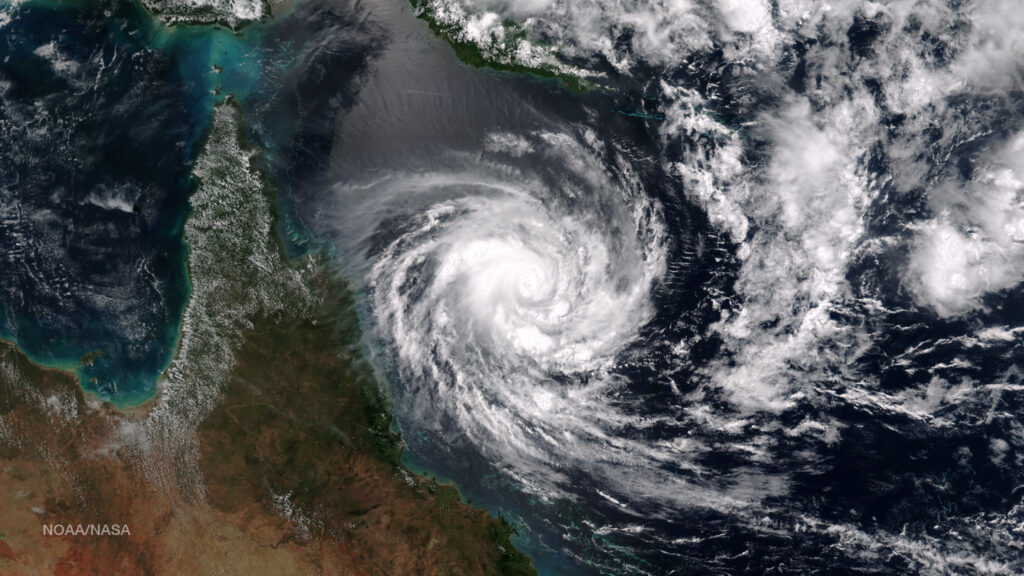A relentless bout of extreme weather has plunged large parts of Australia’s east coast into darkness, with over 120,000 homes and businesses still grappling with power outages. The severe weather, triggered by Cyclone Alfred, which skirted the coast before making landfall as a tropical low, left a devastating mark over a 400-kilometre stretch for nearly five days. Amid the recovery efforts, a tragic incident claimed the life of a 61-year-old man swept off a bridge into a flooded river.
A Storm of Unprecedented Proportions
Cyclone Alfred emerged as a potent reminder of nature’s fury. Initially hovering offshore, the system intensified as it neared the coastline, eventually transforming into a tropical low that battered regions along Queensland and New South Wales. The violent winds, torrential rains, and surging floodwaters persisted for several days, overwhelming infrastructure and disrupting daily life for countless Australians.
The storm’s impact has been far-reaching. Local meteorological services had warned of the approaching system, yet the sheer force and duration of the onslaught caught many by surprise. As the weather began to ease later in the week, the lingering effects of the storm became painfully evident—most notably, the extensive power outages that continue to darken neighborhoods across the region.
Record-Setting Outages and Utility Struggles
In southeast Queensland, the situation is particularly severe. Regional energy provider Energex reported that as of Tuesday morning, 118,000 properties remained without power—a stark statistic in a state where over 450,000 premises lost electricity during the emergency. This figure marks a record for natural disaster-induced outages in Queensland, highlighting both the storm’s ferocity and the challenges utilities face in restoring service.
Utility crews have been working around the clock to repair damaged power lines, clear debris, and restore electrical grids. More than 2,000 staff members are actively engaged in these efforts, with helicopters deployed to survey and reach isolated areas where ground access is restricted by floodwaters and fallen trees. Energex officials are optimistic about making significant progress, with plans to restore power to 95% of the affected properties by Friday, provided that the weather remains cooperative.
In New South Wales, the disruption is somewhat less widespread but still significant. Essential Energy confirmed that around 7,600 homes and businesses are still experiencing power interruptions. The company cautioned residents to expect fluctuating service as repair teams work to resolve faults caused by high winds and debris impacts. Both utility providers are facing an uphill battle in areas where infrastructure had been severely compromised by the storm’s relentless force.
Tragic Loss Amid the Chaos
While the focus remains on restoring power and rebuilding communities, the human cost of the storm has been deeply felt. In a heart-wrenching incident on Friday, a 61-year-old man lost his life when his four-wheel-drive pickup was swept off a bridge by rapidly rising floodwaters. Emergency services rushed to the scene, but efforts to rescue him proved futile as the treacherous conditions claimed another victim.
This tragic loss underscores the dangerous conditions posed by such extreme weather events. The incident has spurred local authorities to issue renewed warnings about the perils of driving in flood-prone areas and to reinforce safety protocols for residents and motorists alike. The storm has not only disrupted daily routines but has also highlighted the urgent need for improved community preparedness in the face of increasingly erratic weather patterns.
Community Response and Resilience
In the wake of the storm, stories of community resilience and solidarity have emerged amid the challenges. Neighbors have banded together to support one another, sharing resources such as portable generators and offering temporary shelter to those whose homes remain in the dark. Local businesses have opened their doors as makeshift hubs where residents can charge their devices, catch up on news, and access basic amenities.
Community centers and councils have been quick to organize relief efforts, distributing bottled water, non-perishable food, and other emergency supplies to vulnerable populations. In some regions, local volunteers have taken the initiative to assist elderly residents and individuals with disabilities, ensuring that no one is left isolated in these difficult times. This spirit of cooperation and mutual aid is a testament to the strength of the communities affected by Cyclone Alfred.

Infrastructure Under Pressure
The widespread power outages have also sparked discussions about the resilience of Australia’s energy infrastructure in the face of extreme weather events. Experts argue that the record-breaking outages experienced during Cyclone Alfred reveal vulnerabilities in the current grid systems, which may require significant upgrades to cope with future storms.
Energy analysts point out that while utility companies like Energex and Essential Energy are working diligently to restore service, the sheer scale of the disaster underscores the need for long-term investment in more robust and weather-resilient infrastructure. Upgrades may include modernizing transmission networks, implementing advanced smart-grid technologies, and reinforcing power lines to better withstand high winds and flooding. Such measures could not only reduce the duration of future outages but also mitigate the economic and social impacts of severe weather.
The Economic Toll of Extended Blackouts
The prolonged power outages have had far-reaching economic consequences. Businesses in affected areas are grappling with halted operations, spoiled inventory, and the cost of backup power solutions. For many small business owners, every hour without power translates into lost revenue and mounting operational challenges.
Agricultural sectors, which form a significant part of the regional economy in parts of Queensland and New South Wales, have also felt the impact. Farm operations reliant on electrical systems for irrigation, processing, and storage have experienced disruptions, potentially jeopardizing harvests and income for local farmers. The economic ripple effect of the storm is likely to be felt for weeks, if not months, as communities work to restore not only power but also economic stability.
Emergency Services and Future Preparedness
In addition to utility companies, emergency services have been on high alert throughout the storm. Firefighters, paramedics, and rescue teams have been deployed to assist those stranded by floodwaters and to manage the hazardous conditions on the roads. The coordinated efforts of these services have undoubtedly saved lives and prevented further tragedies, yet they also serve as a reminder of the immense challenges posed by extreme weather events.
Local government officials are now advocating for a comprehensive review of current emergency response strategies. There is a growing consensus that lessons learned from Cyclone Alfred must be applied to future planning. Proposals include expanding early warning systems, increasing funding for community education programs on disaster preparedness, and investing in infrastructure upgrades that can better withstand similar events. As climate change continues to influence weather patterns, such proactive measures are seen as essential in safeguarding communities against the increasing frequency and intensity of storms.
Looking Ahead: A Call for Resilience and Reform
The aftermath of Cyclone Alfred presents both a challenge and an opportunity. While the immediate priority remains on restoring power and ensuring public safety, the incident also serves as a wake-up call for long-term reforms. Community leaders, policymakers, and industry experts agree that addressing the vulnerabilities exposed by the storm requires a multi-faceted approach—one that combines infrastructure investment, community engagement, and robust emergency planning.
In the coming days, attention will focus on the progress of the power restoration efforts. Utility companies have pledged to keep residents informed through regular updates, and local councils are working closely with state authorities to monitor the situation and coordinate further relief efforts. As the region begins to recover, there will undoubtedly be a period of reflection and planning aimed at building a more resilient future.
Bridging the Gap Between Crisis and Recovery
For many Australians, the events of the past week have been a stark reminder of nature’s unpredictability and the importance of community resilience. As families huddle in darkened homes and businesses brace for the economic impact of extended outages, there is also a renewed sense of determination to rebuild and fortify local infrastructure. The path to recovery will likely be long and fraught with challenges, but it also offers an opportunity to address longstanding issues and to invest in solutions that can protect communities in the years to come.
Government agencies at both the state and federal levels are now under pressure to review existing policies and to commit additional resources to disaster preparedness and infrastructure resilience. The goal is not only to restore normalcy as quickly as possible but also to lay the groundwork for a future where such widespread disruption is less likely. By learning from the experiences of Cyclone Alfred, Australia can take decisive steps toward mitigating the impact of future storms and ensuring that communities are better equipped to face the challenges ahead.
Conclusion
Cyclone Alfred’s impact on Australia’s east coast has been profound, leaving over 120,000 properties in darkness and marking a tragic loss of life amid the chaos of extreme weather. The extensive power outages and record-setting disruptions have laid bare the vulnerabilities in the current infrastructure, while the heroic efforts of utility workers, emergency responders, and community volunteers underscore the resilience of those affected.










